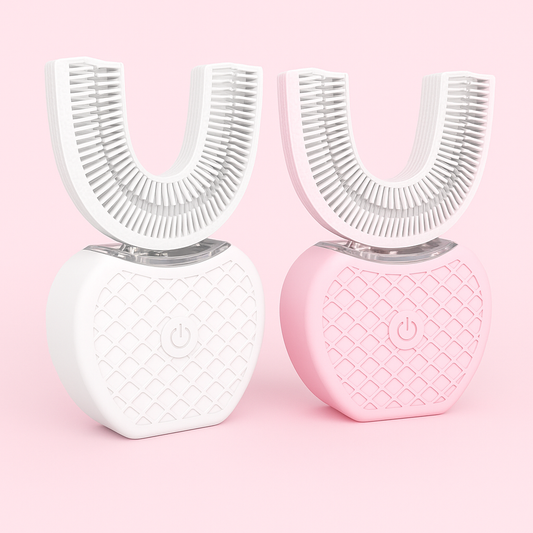Introduction: Why a low-risk whitening switch makes sense
If you're looking for a gradual, safer approach to brighter teeth, switching to a fluoride-free whitening toothpaste that contains xylitol and niacinamide is a smart option. This article explains how these ingredients work, how to choose the best product, how to read labels, and how to use a fluoride-free, xylitol- and niacinamide-containing toothpaste as part of a complete plan for healthier teeth and a whiter smile.
Quick primer: extrinsic vs intrinsic stains
- Extrinsic stains: Surface discoloration caused by coffee, tea, wine, smoking, certain foods, and biofilm. These are the easiest to manage with toothpaste, polishing, and improved oral hygiene.
- Intrinsic stains: Discoloration within the tooth structure (tetracycline staining, trauma, aging). These often require professional whitening or restorative dentistry.
Fluoride-free toothpaste with xylitol and niacinamide is aimed mainly at controlling extrinsic stains while improving oral health—not delivering bleach-level whitening.
Understanding the three star ingredients: fluoride (or choosing to avoid it), xylitol, and niacinamide
Before you switch, it helps to know what each key ingredient does and why you might want it or avoid it.
Fluoride: the cavity fighter (and reasons people skip it)
- Benefits: Fluoride strengthens enamel and reduces cavity risk. It is well-supported by decades of evidence for caries prevention.
- Why some avoid it: Concerns about ingestion (especially for small children), personal preference for fluoride-free routines, or desire to use alternative remineralizing agents like hydroxyapatite.
- Important note: If you stop using fluoride, make sure you have an alternative plan for cavity prevention—discuss with your dentist before making the switch, especially for high-caries-risk individuals.
Xylitol: an evidence-backed protector and stain-manager
Xylitol is a sugar alcohol used as a sweetener and an antimicrobial oral agent. Its benefits include:
- Reducing Streptococcus mutans adhesion and acid production, thereby lowering caries risk.
- Helping maintain a neutral oral pH, which limits enamel-degrading acid attacks and reduces staining susceptibility.
- Providing a pleasant taste without promoting plaque-causing bacteria.
How to spot it on labels: Xylitol commonly appears as "xylitol" in the ingredient list. For effect, it should be prominent (listed earlier rather than as a trace sweetener).
Niacinamide (vitamin B3): anti-inflammatory, supportive, not a bleach
Niacinamide is increasingly used in oral-care formulations for tissue support and inflammation reduction. It:
- Helps soothe gums and may reduce gingival inflammation, making teeth look healthier.
- Supports cellular energy pathways and tissue repair, potentially improving mucosal health over time.
- Is not a peroxide-based bleaching agent—expect supportive benefits rather than dramatic whitening.
Other supportive ingredients to look for
- Hydroxyapatite: a remineralizing alternative to fluoride that can help fill micro-defects in enamel and reduce sensitivity.
- Mild polishing agents (fine silica): remove surface stains gently when RDA is low.
- Enzymes (e.g., papain, bromelain): can help break down biofilm and surface staining when formulated correctly.
- Essential oils and xylitol-containing mouthwashes: support the oral microbiome and freshness without alcohol.
Ingredients and practices to avoid or be cautious about
- High-abrasion charcoal and coarse silica: these can remove enamel over time and increase long-term staining or sensitivity.
- High-concentration peroxides in unsupervised home products: can cause sensitivity and enamel changes without dentist guidance.
- Sodium lauryl sulfate (SLS): may aggravate mouth ulcers in sensitive people.
- Hidden sweeteners listed far down the ingredients list as a placebo rather than a functional concentration of xylitol.
Understanding RDA (Relative Dentin Abrasivity) and why it matters
RDA is a standardized measure of how abrasive a toothpaste is. Key points:
- RDA < 70 is generally considered low-abrasion and safe for daily use on enamel.
- RDA 70–100 is moderate; acceptable for some users but monitor for sensitivity over time.
- RDA > 100 is abrasive and not recommended for routine whitening toothpaste use.
- If a toothpaste doesn’t publish RDA, treat with caution—brands that disclose RDA are more transparent and often more trustworthy.
How to read labels like an oral-care pro
Label-reading tips that help you choose the best toothpaste without fluoride:
- Ingredient order: ingredients are listed from highest to lowest quantity. Find xylitol and niacinamide near the top for likely efficacy.
- Check for RDA and clinical claims: look for published studies or links on the brand site.
- Look for the words "fluoride-free", "xylitol", "niacinamide", "hydroxyapatite", or "low abrasion" on packaging or product pages.
- Watch out for ambiguous marketing: "natural" or "whitening" alone doesn’t speak to safety or effectiveness.
Checklist: How to choose the best fluoride-free whitening toothpaste with xylitol & niacinamide
- Contains xylitol listed prominently in the ingredient list.
- Includes niacinamide or other tissue-supporting agents.
- Low RDA (< 70) or clearly labeled "low abrasion".
- Includes enamel-supportive actives like hydroxyapatite if you are avoiding fluoride entirely.
- Does not contain heavy charcoal, coarse abrasives, or high concentrations of peroxides.
- Transparent labeling and clinical claims, plus user reviews referencing reduced sensitivity and improved stain control.
- Appropriate flavor and SLS-free option if you have ulcers or mucosal sensitivity.
Practical switching plan — 8-week protocol
Give any new toothpaste a proper trial and evaluate real benefits:
- Week 1: Replace your toothpaste with the new fluoride-free xylitol/niacinamide paste. Use twice daily with a soft brush. Track comfort and taste.
- Weeks 2–4: Continue twice daily. Add xylitol gum or mints after meals to extend the antimicrobial benefit. Note staining changes and sensitivity.
- Weeks 5–8: Assess results. Minor surface brightening and reduced plaque should be observable. If new cavities or sensitivity appear, consult a dentist and consider adding a topical fluoride treatment if necessary.
Complementary habits that boost whitening and oral health
- Brush gently for two minutes twice daily with a soft-bristled brush.
- Floss daily to remove interproximal staining and plaque.
- Rinse with water after staining foods/drinks and wait 30–60 minutes to brush after acidic exposure.
- Chew xylitol gum after meals (if permitted) to reduce acid challenges and feed oral-care benefit between brushes.
- Limit smoking, frequent coffee, tea, and red wine; use a straw for beverages when possible.
Special populations: tailored advice
- Children: Avoid fluoride elimination for high-risk children without professional guidance. If using fluoride-free toothpaste, check age recommendations and ensure supervised brushing to minimize ingestion.
- Pregnancy and breastfeeding: Most toothpaste ingredients are safe, but consult your healthcare provider if you’re concerned about removing fluoride or starting new actives.
- Dry mouth (xerostomia): Xylitol-containing toothpaste can be helpful. Also consider saliva-stimulating products and professional evaluation.
- Orthodontic patients: Prioritize low-abrasion formulas to protect brackets and enamel; use interdental brushes to remove staining around appliances.
Combining a fluoride-free whitening toothpaste with professional treatments
You can often combine a fluoride-free low-abrasion toothpaste with dental treatments, but coordinate with your dentist:
- In-office bleaching: Follow your dentist's guidance. Post-bleaching sensitivity might call for remineralizing agents like hydroxyapatite or a temporary return to fluoride.
- Professional cleanings (prophylaxis) will remove stubborn extrinsic stains; maintain results with your xylitol/niacinamide toothpaste.
- Prescription fluoride varnishes or gels can be applied by your dentist even if you use fluoride-free toothpaste daily, giving targeted remineralization when needed.
Common mistakes to avoid
- Expecting peroxide-level whitening from a non-bleaching toothpaste.
- Using abrasive charcoal formulas daily and damaging enamel over time.
- Switching toothpaste without considering overall caries risk or professional advice for vulnerable patients.
Daily routines: sample morning and evening
Sample morning routine:
- Rinse mouth with water if you drink coffee immediately; brush after 30 minutes with fluoride-free xylitol/niacinamide paste.
- Floss and use an alcohol-free mouthwash if desired.
- Chew xylitol gum after breakfast if on the go.
Sample evening routine:
- Brush for two minutes with the same toothpaste. Nighttime is key for remineralization and bacterial control.
- Use interdental cleaning where needed; consider an overnight remineralizing gel if recommended by your dentist.
Extended FAQs
- Will a fluoride-free toothpaste make my teeth weaker? Not necessarily. If you switch, include alternative remineralizing ingredients like hydroxyapatite and maintain regular dental check-ups. People at high risk for cavities should consult their dentist first.
- How much xylitol is effective? Clinical benefit tends to correlate with quantity and frequency. In toothpaste, higher placement in the ingredient list suggests a meaningful concentration. Complement toothpaste with xylitol gum or mints for added dosing.
- Is niacinamide safe in toothpaste? Yes—niacinamide is well-tolerated and used for anti-inflammatory benefits. It is not a bleaching agent, so set expectations accordingly.
- How long until I see whitening effects? Expect gradual improvements in 4–8 weeks for surface stain reduction with consistent use and good oral hygiene.
SEO-savvy search terms to use when shopping
To find or promote products online, use combined phrases such as:
- "best toothpaste for whiter teeth"
- "toothpaste without fluoride"
- "toothpaste with xylitol"
- "niacinamide toothpaste"
- "toothpaste that whitens teeth"
- "good whitening toothpaste"
- "fluoride toothpaste free"
Final thoughts: an evidence-informed, low-risk whitening strategy
Switching to a fluoride-free whitening toothpaste that includes xylitol and niacinamide can be part of a thoughtful, low-risk strategy to support healthier teeth and gradual surface whitening. Choose a low-abrasion formula with transparent labeling, pair it with consistent oral hygiene, and consult your dentist if you have elevated cavity risk or significant staining.
For curated, thoughtfully formulated options that emphasize "best toothpaste whitening teeth", "toothpaste without fluoride", and "toothpaste with xylitol", explore Havana Body's oral-care collection. Their product pages highlight ingredient transparency and supportive formulas—check them out here: best toothpaste for whiter teeth, toothpaste without fluoride, and toothpaste with xylitol.
If you're ready to try a gentle, health-forward whitening switch, visit Havana Body to browse and purchase their oral-care products: Shop Havana Body. Consider starting a monitored 8-week trial and discuss options with your dental professional for the best long-term results.


